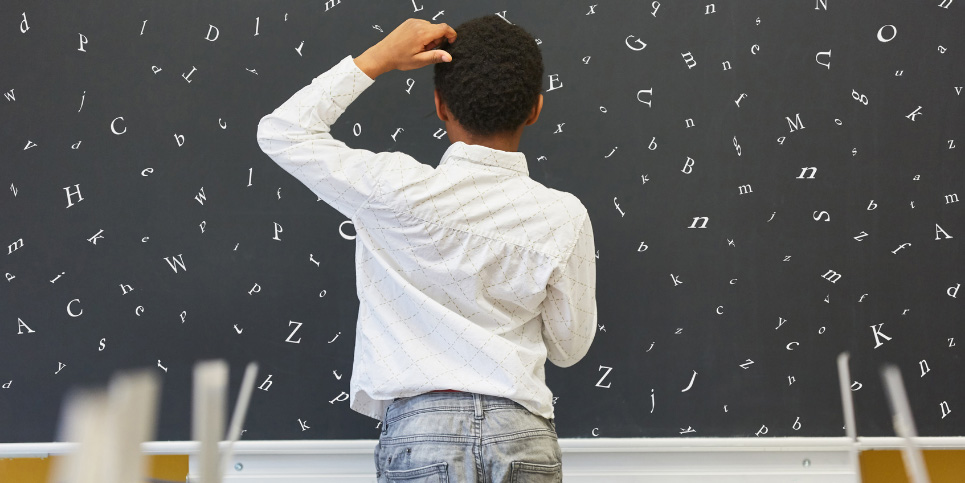Growing Readers: Learning to Love Reading and Writing Column 16
This editorial article was written by Lizzie Mussoline, M. Ed.
October is National Dyslexia Awareness Month and it’s a great time to share information, resources, and success stories about dyslexia. While the actual percentage of people suffering from dyslexia is unknown, experts report that a significant percentage of the population shows some signs of this learning disorder. Without identification or early intervention, dyslexia can negatively impact self-esteem and motivation to read and learn, which can have devasting effects later in life. Dyslexia cannot be outgrown or cured, but it can be remediated with proper intervention. Knowing more can literally change a child’s life.
What is Dyslexia?
The International Dyslexia Association (IDA) defines dyslexia as a: “specific learning disability that is neurobiological in origin. It is characterized by difficulties with accurate and/or fluent word recognition and by poor spelling and decoding abilities. These difficulties typically result from a deficit in the phonological component of language that is often unexpected in relation to other cognitive abilities and the provision of effective classroom instruction. Secondary consequences may include problems in reading comprehension and reduced reading experience that can impede growth of vocabulary and background knowledge.”
What Dyslexia Is Not:
- Seeing letters backward or in reverse, although children with dyslexia do tend to struggle with proper letter formation.
- Writing letters backward. This is developmentally appropriate until the end of first or even second grade (b, d, p, q).
- A vision or sight problem.
- A developmental phase that can be grown out of.
What Dyslexia Is:
- Neurobiological, which means it is caused by different wiring in the brain.
- Causes difficulty retaining phonemes (sounds) and letter-sound correspondence. Those with dyslexia need hundreds of exposures to something a child without dyslexia might retain in a day or two.
- Children with dyslexia are consistently inconsistent. They may seem to have a good grasp with a skill one day and not at all on another day. They may also have difficulties with other language skills such as spelling, writing, and pronouncing words.
- There is NO relationship between IQ and dyslexia. In fact, if there is a big difference between reading ability and IQ, this can be a warning sign of dyslexia.
- It is genetic. Children have a 50% chance of having dyslexia if one parent has it and a 100% chance if both parents have it. Dyslexia ranges from mild to severe. Around 40% of people with dyslexia also have ADHD.
- Language-based learning disability. Dyslexia refers to a cluster of symptoms, which results in people having difficulties with specific language skills, particularly reading. Students with dyslexia usually experience difficulties with other language skills such as spelling, writing, and pronouncing words.
This is a LOT of information. Let’s break it down a bit!
- Dyslexia is a different wiring of the brain (neurobiological) that causes difficulty with letter-sound correspondence and thus decoding (reading), and retention of information necessary for success in/with reading (reading comprehension, etc.).
- It can cause larger problems if not addressed/identified, such as low self-esteem, lack of motivation to learn, overall happiness and well-being.
- There is a broad spectrum of dyslexia. It can range from mild to severe.
- There is no cure, but early intervention is KEY and will help those with dyslexia learn to read in ways that help their brains work their best.
The Signs of Dyslexia
Since early intervention is KEY, it is important to know the signs of dyslexia, which can present as early as in Preschool. Some issues to be aware of are:
- Mispronouncing words, like saying “beddy tear” instead of “teddy bear.”
- Struggling to name familiar objects and instead using general words like thing and stuff.
- Having a hard time learning nursery rhymes or song lyrics that rhyme.
- Having trouble remembering sequences, like singing the letters of the alphabet.
- Telling stories that are hard to follow; trouble talking about an event in a logical order.
- Difficulty remembering and following directions with multiple steps.
- Difficulty with phonological awareness, sound/symbol correspondence (letter/sound identification), rapid naming (how quickly one can name aloud objects, pictures, colors, symbols), oral language (ability, vocabulary, listening comprehension).
How You Can Help a Child with Dyslexia
Foster skills that help build a strong reading foundation for reading success.
Children need to have:
- strong phonemic awareness (the ability to hear and manipulate different sounds or phonemes);
- letter/sound correspondence & alphabet knowledge;
- high-frequency word knowledge; and
- rhyming background.
What should you do if you’re a parent of a child you think might be dyslexic?
- Think about whether you or anyone in your family may have struggled to read as a child.
- Refer to the skills that children with dyslexia may struggle with and begin to collect any data or anecdotal notes/thoughts you have on this and ask a teacher, tutor, or caregiver to do the same.
- If your child is in school, ask a teacher how they are working on phonological awareness and what you can do at home to support it (the knowledge of sounds (phonemes) and playing and manipulating phonemes).
- Do the same regarding sound/symbol correspondence & (letter/sound correspondence. This is taught in school, but inquire about how you can practice and reiterate at home.
- To work on rapid naming, play a fun game called Spot It, which is excellent for strengthening this skill!
- To help strengthen oral language skills such as vocabulary & listening comprehension: Talk, Talk, Talk, Read, Read, Read, and listen to audiobooks and podcasts.
- Continue to do all you can to instill and create a love of reading and learning in your home!
- To gather more information, you can begin a “frustration log,” which will help you and educators start to understand your child’s areas of concern.
It is important to know that early intervention is incredibly effective. There is a much better chance of remediation, bringing a child to grade level, and an increase in gray matter in the brain (increased activity in the frontal and temporal lobe) with early intervention. This is incredible! Dyslexia is much more complicated than struggling with reading. If your child, or someone you know, is struggling with reading or writing, reach out to anyone who may spend time with your child, and/or educators, so that you can start to have essential conversations and begin the steps needed to help increase the child’s reading and writing skills, and in turn, their self-esteem.
Helpful Resources:
More of a visual and/or auditory learner? Me, too! Here are a few videos about Dyslexia and the Brain:
- https://www.understood.org/en/learning-thinking-differences/child-learning-disabilities/dyslexia/video-dyslexia-and-the-brain
- https://www.youtube.com/watch?v=zafiGBrFkRM
- https://www.pbs.org/video/dyslexia-1556666976/
—
Thank you for reading the Growing Readers: Learning to Love Reading and Writing column. Bookmark this Growing Readers Column link or subscribe to our e-newsletter so you do not miss out on the monthly reading tips. What to do When Your Child Hates to Read was written by Lizzie Mussoline, M. Ed.—follow her on Instagram: @wildflower_learning_denver.


